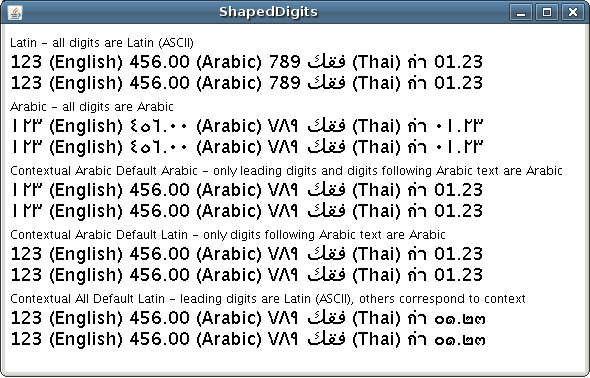Lesson: Working with Text
Converting Latin Digits to Other Unicode Digits
By default, when text contains numeric values, those values are displayed using Latin (European) digits. When other Unicode digit shapes are preferred, use the
java.awt.font.NumericShaper class. The NumericShaper API enables you to display a numeric value represented internally as an ASCII value in any Unicode digit shape.
The following code snippet, from the
ArabicDigits example, shows how to use a NumericShaper instance to convert Latin digits to Arabic digits. The line that determines the shaping action is bolded.
ArabicDigitsPanel(String fontname) {
HashMap map = new HashMap();
Font font = new Font(fontname, Font.PLAIN, 60);
map.put(TextAttribute.FONT, font);
map.put(TextAttribute.NUMERIC_SHAPING,
NumericShaper.getShaper(NumericShaper.ARABIC));
FontRenderContext frc = new FontRenderContext(null, false, false);
layout = new TextLayout(text, map, frc);
}
// ...
public void paint(Graphics g) {
Graphics2D g2d = (Graphics2D)g;
layout.draw(g2d, 10, 50);
}
The NumericShaper instance for Arabic digits is fetched and placed into a HashMap for the
TextLayout.NUMERIC_SHAPING attribute key. The hash map is passed to the TextLayout instance. After rendering the text in the paint method, the digits are displayed in the desired script. In this example, the Latin digits, 0 through 9, are drawn as Arabic digits.

The previous example uses the NumericShaper.ARABIC constant to retrieve the desired shaper, but the
NumericShaper class provides constants for many languages. These constants are defined as bit masks and are referred to as the NumericShaper bit mask-based constants.
Enum-Based Range Constants
An alternative way to specify a particular set of digits is to use the
NumericShaper.Range enumerated type (enum). This enum, introduced in the Java SE 7 release, also provides a set of
constants. Although these constants are defined using different mechanisms, the NumericShaper.ARABIC bit mask is functionally equivalent to the NumericShaper.Range.ARABIC enum, and there is a corresponding getShaper method for each constant type:
The
ArabicDigitsEnum example is identical to the ArabicDigits example, except it uses the NumericShaper.Range enum to specify the language script:
ArabicDigitsEnumPanel(String fontname) {
HashMap map = new HashMap();
Font font = new Font(fontname, Font.PLAIN, 60);
map.put(TextAttribute.FONT, font);
map.put(TextAttribute.NUMERIC_SHAPING,
NumericShaper.getShaper(NumericShaper.Range.ARABIC));
FontRenderContext frc = new FontRenderContext(null, false, false);
layout = new TextLayout(text, map, frc);
}
Both getShaper methods accept a singleRange parameter. With either constant type, you can specify a range of script-specific digits. The bit mask-based constants can be combined using the OR operand, or you can create a set of NumericShaper.Range enums. The following shows how to define a range using each constant type:
NumericShaper.MONGOLIAN | NumericShaper.THAI |
NumericShaper.TIBETAN
EnumSet.of(
NumericShaper.Range.MONGOLIAN,
NumericShaper.Range.THAI,
NumericShaper.Range.TIBETAN)
You can query the NumericShaper object to determine which ranges it supports using either the
getRanges method for bit mask-based shapers or the
getRangeSet method for enum-based shapers.
Note:
You can use either the traditional bit masked-based constants or the Range enum-based constants. Here are some considerations when deciding which to use:
- The
RangeAPI requires JDK 7 or later. - The
RangeAPI covers more Unicode ranges than the bit-masked API. - The bit-mask API is a bit faster than the
RangeAPI.
Rendering Digits According to Language Context
The
ArabicDigits example was designed to use the shaper for a specific language, but sometimes the digits must be rendered according to the language context. For example, if the text that precedes the digits uses the Thai script, Thai digits are preferred. If the text is displayed in Tibetan, Tibetan digits are preferred.
You can accomplish this using one of the getContextualShaper methods:
- getContextualShaper(int ranges)
- getContextualShaper(int ranges, int defaultContext)
- getContextualShaper(Set<NumericShaper.Range> ranges)
- getContextualShaper(Set<NumericShaper.Range> ranges, NumericShaper.Range defaultContext)
The first two methods use the bit-mask constants, and the last two use the enum constants. The methods that accept a defaultContext parameter enable you to specify the initial shaper that is used when numeric values are displayed before text. When no default context is defined, any leading digits are displayed using Latin shapes.
The
ShapedDigits example shows how shapers work. Five text layouts are displayed:
- The first layout uses no shaper; all digits are displayed as Latin.
- The second layout shapes all digits as Arabic digits, regardless of language context.
- The third layout employs a contextual shaper that uses Arabic digits. The default context is defined to be Arabic.
- The fourth layout employs a contextual shaper that uses Arabic digits, but the shaper does not specify a default context.
- The fifth layout employs a contextual shaper that uses the
ALL_RANGESbit mask, but the shaper does not specify a default context.

The following lines of code show how the shapers, if used, are defined:
- No shaper is used.
NumericShaper arabic = NumericShaper.getShaper(NumericShaper.ARABIC);NumericShaper contextualArabic = NumericShaper.getContextualShaper(NumericShaper.ARABIC, NumericShaper.ARABIC);NumericShaper contextualArabicASCII = NumericShaper.getContextualShaper(NumericShaper.ARABIC);NumericShaper contextualAll = NumericShaper.getContextualShaper(NumericShaper.ALL_RANGES);
See the
ShapedDigits.java example for further implementation details.